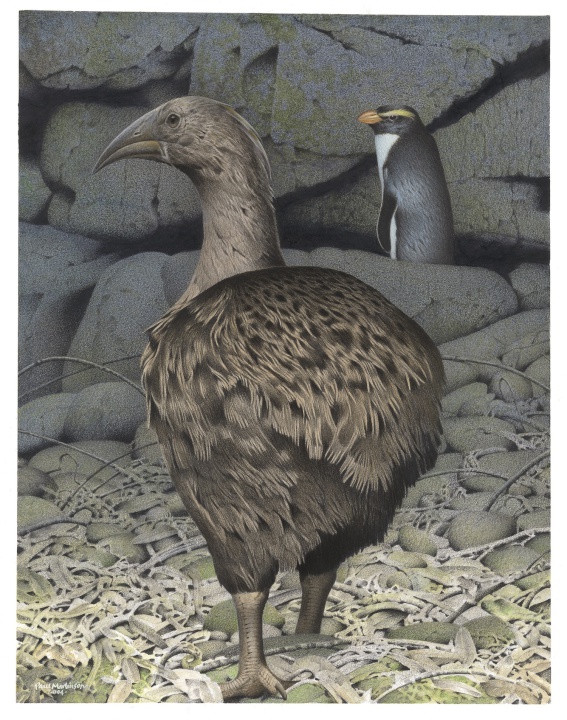African Origins for the Enigmatic Adzebill

The ancestor of New Zealand’s most mysterious giant bird – the extinct adzebill – likely flew here from Madagascar, Africa, new research has revealed.
An international team of scientists led by the University of Adelaide and including Dr Paul Scofield, Senior Curator Natural History at Canterbury Museum and Alan Tennyson, Vertebrate Curator at the Museum of New Zealand Te Papa Tongarewa, analysed adzebill DNA extracted from fragments of bone and eggshell.
Comparing adzebill DNA to that of modern bird species led the team to a surprising conclusion: the closest living relative of these extinct New Zealand giants is the tiny Madagascan Flufftail, which weighs less than 50 g. Adzebills could weigh up to 19 kg.
These results, published recently in the journal Diversity, overturn a previous theory that the adzebill’s ancestors were in New Zealand when it was still connected to the supercontinent Gondwana, more than 52 million years ago.
Scofield says the adzebill’s ancestors likely flew to New Zealand from Madagascar between 40 and 22 million years ago. After arriving here, the species grew rapidly, increasing more than 50-fold in mass.
“Adzebills became almost totally wingless but they gained these huge reinforced beaks, which might have been used for digging or to attack prey,” Scofield says.
New Zealand had two distinct species of adzebills: the smaller North Island Adzebill and the larger South Island Adzebill.
“The two species likely evolved relatively recently,” Scofield says. “The separation of the genus into two species probably occurred when the Manawatu Strait separated New Zealand into two islands between 1 and 2 million years ago.”
Adzebills died out after early Māori arrived in New Zealand, around the same time as other native giants like the moa and Haast’s Eagle.
“If they hadn’t gone extinct, they would be among the largest living birds,” says Alexander Boast of the University of Adelaide, the study’s lead author.
Adzebills are not the only New Zealand bird with relatives in Madagascar. Recent research has suggested the iconic kiwi is the closest living relative of the extinct Madagascan Elephant Bird, while the Madagascan Teal has shared ancestry with New Zealand teal species.
Dr Kieren Mitchell from the University of Adelaide, another of the study’s co-authors, says the ancestors of these birds might have arrived in New Zealand via Antarctica.
“Some coastal regions of Antarctica remained forested and ice free until as recently as 30 million years ago.”
To cite this paper: Boast AP, Chapman B, Herrera MB, Worthy TH, Scofield RP, Tennyson AJD, Houde P, Bunce M, Cooper A, Mitchell KJ. 2019. Mitochondrial Genomes from New Zealand’s Extinct Adzebills (Aves: Aptornithidae: Aptornis) Support a Sister-Taxon Relationship with the Afro-Madagascan Sarothruridae. Diversity.
ends


 Whanganui Regional Museum: Historic Wedding Dress Unveiled, A Piece Of Marton’s Heritage
Whanganui Regional Museum: Historic Wedding Dress Unveiled, A Piece Of Marton’s Heritage Donovan Ryan: Local Runner Takes Out Frontrunner Christchurch Marathon
Donovan Ryan: Local Runner Takes Out Frontrunner Christchurch Marathon University of Auckland: Tributes Flow For Much Loved Pacific Leader Melegalenu’u Ah Sam
University of Auckland: Tributes Flow For Much Loved Pacific Leader Melegalenu’u Ah Sam NZEI: Ministry Of Education Cuts Will Disproportionately Affect Pasifika
NZEI: Ministry Of Education Cuts Will Disproportionately Affect Pasifika Day One Hapai te Haeata: Call To Action For Young Filmmakers Against The Backdrop Of Funding Cuts
Day One Hapai te Haeata: Call To Action For Young Filmmakers Against The Backdrop Of Funding Cuts Toyota New Zealand: Three Races For Top Three To Decide TR86 Title
Toyota New Zealand: Three Races For Top Three To Decide TR86 Title